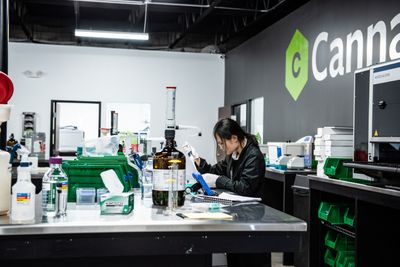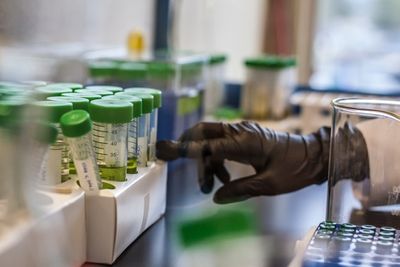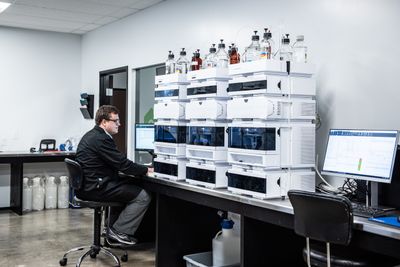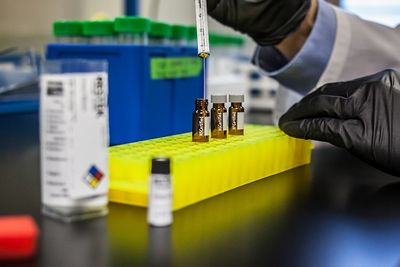Lead photo courtesy of Evio Labs
The promise of lab-tested weed has been among the major selling points for cannabis legalization campaigns across the country. Yet, to date, it's unclear whether we can actually rely on lab testing to tell us the truth — at least, consistently — about what's in our pot. Without nationwide standards to regulate cannabis laboratory equipment and methodology, our ability to trust in lab-tested pot has been reduced to a game of guesswork.
The costs of meeting testing requirements for growers, manufacturers, and retailers; the different testing methods labs are using; and the advent of "lab shopping" — whereby products are tested at different labs in order to get the most favorable results — all threaten to undermine the credibility of lab-tested cannabis, and thus, any guarantee that legal weed is safe or consistent for consumers. In fact, nearly 20 percent of cannabis products in California have failed potency and purity tests since the state began to require these checks on July 1st of this year.
"Every lab we've gone to has been different; there's no standardization," says Mike Reynolds, CEO of Kase Manufacturing in California, who, as a producer of cannabis tinctures, topicals, and vapes, reports he's observed variance in THC test results of up to 30 percent from one lab to another. Both potency and pesticide testing have yielded disparate numbers, he says, with one lab testing 92 percent for a certain potency and another testing 78 percent on the same material. "We want to trust that we're giving healthy and clean medicine to people, and at the same time it's been really horrific," he says. "How do you trust anything?"
It's quite standard for cannabis producers to try multiple testing labs, Reynolds says, noting that he often chooses results from whichever lab gets them back the most quickly. The lab he uses now takes roughly about five days, assuming nothing goes wrong. Reynolds also does his own THC and CBD potency testing before sending the material out to labs.
Daniel Wacks, CEO of State Flower Cannabis, has also gone lab shopping, both in California and Nevada. "Testing labs run the gamut in terms of pricing, turnaround times, and customer service," he says. For example, because state-level regulations provide a very general definition as to how a 'representative sample' of a particular batch of marijuana flowers should be collected, some labs consistently collect a variety of bud sizes from various areas within the batch sent out for testing. Other labs function under a looser interpretation of 'representative sample,' tending to favor medium to larger buds with more visible trichomes, Wacks notes, in order to ensure their clients receive a higher potency on the Certificate of Analysis for a given product.
Meanwhile, Wacks adds, although some labs are careful to change gloves in between collecting samples from each batch — or everytime a technician sneezes, coughs, or touches their phone or any object outside the testing batch — other labs are not nearly as diligent.
Photo courtesy of CannaSafe
While Wacks, too, has received varying results from multiple labs, he notes that in most states with stricter lab testing requirements, you can't retest the same exact sample at a different lab. "Some states allow operators to select their own sample for R&D [research and development] testing only (California and Nevada included), the results of which are kept between the operator and the lab," he says. "This can be a really helpful tool for operators who are looking to experiment with new genetics and want to ensure that the clones they acquired are free of banned pesticides (some systemic pesticides can remain detectable for multiple generations), or want to confirm that a new strain they test ran is high enough potency to be considered commercially viable."
Results from R&D testing do not enable operators to sell the batch from which the sample was collected, unless it has passed compliance testing as well, he adds. "Because R&D testing is not a requirement, it is essentially an additional, and some might say, unnecessary expense to get product to market, and is therefore a very underutilized tool that could enable operators to better understand the variables involved in the testing process." The R&D testing results tend to be much more predictable from a sample that you submit yourself, versus one that the lab selects for you, Wacks adds. "Potency, for example, can vary drastically from sample to sample."
The cost of testing is another issue, and one that ultimately trickles down to the consumer. Stricter regulations and increased demand have forced labs to acquire more sophisticated equipment and scale quickly, which has led to higher testing costs, says Wacks. He notes, however, that as more competition enters the cannabis lab space, the cost of testing is likely to fall. For example, California has only issued 33 testing lab licenses to date, while permitted labs have been so backed up with industry customers that it's taken up to 15 days, or three times the regular timeline, for them to return results — an indicator, he adds, of lagging competition.
On average, sample batch size should fall around 50 pounds, per regulations such as in California. Meanwhile, testing itself should cost around $500 per batch, but can be as high as $1000, depending on product type, a given lab, and date of testing.
Photo courtesy of Evio Labs
In a state like Oregon, on the other hand, which arguably gave out too many licenses and regulated for smaller batch sizes in testing, the overproduction of cannabis not only drove down wholesale prices to $500 a pound, but producers were also asked to test every ten pounds for $500 a batch. "People say this is ridiculous, but that's not the cost of testing's fault," says Josh Wurzer, president of cannabis testing firm SC Laboratories, Inc. "The consumer wants cannabis that's reasonably priced, but also safe, and they shouldn't have to make a decision between the two." In developing regulations around cannabis testing, the batch size can affect the cost of the finished unit for the customer, he says.
"It's a matter of finding the sweet spot with regulators, where we're testing for as many things as appropriate, but they're not making batch sizes so small that it gets to be really expensive per unit," Wurzer says. "You also don't want batch sizes so big that you're not getting a representative sample."
The definition of a batch itself, is not so straightforward — at least to laymen. $600 or $700 worth of testing on a 50-pound batch will be worth $100,000 in wholesale sales, which is less than one percent of the batch cost going to quality control, says Wurzer, and that’s considered reasonable. "The 50 pounds would all be one strain from one field; it should all be the same cannabis," he says. "We send our sampler or field technician to the distributor, who has all 50 pounds in totes or containers of some sort. Our technician pulls small amounts from each container, then mixes it all together to homogenize it and then do one set of tests form the amount that was collected from that 50-pound batch." That's what's called a “representative sample” — one test for all 50 pounds.
As far as methodology goes, each lab needs to go through a "validation procedure" to scientifically prove that the way they're testing is correct, since standard reference methods don't exist for cannabis testing, Wurzer explains. "For instance, Colorado and Washington didn't do a good job of enforcing for the labs that they do proper validation on their methods. You had some instances where labs were falsifying data, and unless the state is checking on the labs and has good oversight, that's bound to happen, because there is a lot of money involved and shady characters."
On the other hand, what California and Oregon got right, he adds, is the requirement that all labs get accredited. In Oregon, for example, there's a National Environmental Lab Accreditation Program throughout the state, with which regulators examine a lab's quality control systems and methodology. In California, Colorado, Massachusetts, and other states, labs must also adhere to ISO 17025 — an international gold standard for testing laboratories — which verifies competency for sampling and evaluation, whether it's food, environmental resources, or cannabis.
Employee with liquid chromatography equipment used to analyze samples; photo courtesy of CannaSafe
In California, products are tested at the distributor level, so that they are tested in the final, packaged form that consumers will ultimately buy. Cannabis in the Golden State is tested for (take a deep breath) cannabinoid content; five different microbiological pathogens; four species of fungus aspergillus; heavy metals; mycotoxins; moisture content (to make sure it doesn't mold on the shelf); nutraceuticals (for cannabis food products); dozens of pesticides; terpene content (if the label makes any terpene claims); and residual solvents and processing chemicals (in the case of concentrates).
"Nobody has put out data that can stand the test of time that says what the best way to test for pesticides is," says Aaron Riley, president of CannaSafe Labs in California. (And let's not forget about California's 20 percent failure rate for lab-tested cannabis products.) While lab variance can feel like stepping onto two different scales and getting half-pound different results, some labs simply don't have the right methodology or equipment. "To test how California wants you to test with detection limits and requirements, you'd be hard pressed to set up a small lab for $1.5 million," he says. "That's as cheap as you could go, and I don't know if you could do it for that much."
The equipment alone costs about $700,000, Riley says, and can greatly affect the quality of a lab's results. "The lab needs to make the proper investment for their testing to be up to par," he says.
Meanwhile, in Massachusetts, the Cannabis Control Commission is in the process of finalizing regulations and licensing for a Standards Testing Laboratory to systematically audit and very testing results from independent testing labs across the state. "Included with this will be a 'secret shopper' program where dispensaries or other retailers will not know when a product is being purchased to double-check the testing results," says Joe Crinkley, public relations and marketing manager for MCR Labs. These steps are meant to ensure that pot shops demand testing procedures which are effective and accurate, so they're not caught dispensing product with unreliable or unreplicable results, he adds. "Additionally, this will put pressure on labs like ours to employ techniques that generate precise and reliable results, and avoid practices that could lead to discrepancies in the data we're providing to clients and regulators."
However, even with accreditation and proficiency testing, there will always be some minor variance from lab to lab, says Lori Glauser, COO of Evio Labs. "Some of the variation comes from the samples themselves, some from the instruments, and some from the analysts working on the tests. This does not mean any one lab is ‘better’ than another."
Photo courtesy of Evio Labs
To ensure that lab-tested cannabis is viable and trustworthy, Glauser suggests labs not only be accredited (which is happening in most states), but that labs, by themselves or through an independent third party, be responsible for sampling product from the manufacturer's batch. "If self-sampling, manufacturers and distributors have incentive to provide the highest quality, cleanest bud in the entire batch for testing — and that is not representative of the entire batch," she says. Only a handful of states require sampling: Oregon, Nevada, and now California among them.
Consumers must also be educated that higher potency does not mean "better" (and therefore more valuable), Glauser underscores. "There is so much more to cannabis and its effects than the amount of THC."
In the early stages of legalization, lab testing still has kinks to work out in terms of reliability and standardization — and the latter will certainly boost the former. While the current state of lab testing remains shaky, and at times untrustworthy, the presence and further development of testing requirements and regulations in terms of methodology, equipment, standard batch sizes, and so forth — not only within a given state, but among multiple states that have legalized cannabis — may soon help a gold standard emerge which cannabis testing labs can adhere to, no matter their size or location. In the meantime, however, consumers need to do their own research, scrutinizing the results on a product's label, interrogating brands as to their testing practices, and who's doing the testing. Nearly as important as the integrity of the cannabis brand itself, is the integrity of the lab that's testing it.



